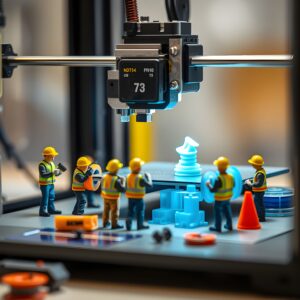3D Printing in Aerospace: Pushing the Boundaries of Space Exploration

Explore how 3D printing is revolutionizing the aerospace industry, from manufacturing lightweight components to enabling sustainable space exploration.
The aerospace industry has always been at the forefront of technological innovation, and 3D printing is proving to be one of its most transformative tools. In August 2024, significant advancements in 3D printing technology continued to push the boundaries of what is possible in aerospace, leading to more efficient manufacturing processes, lighter and stronger components, and new possibilities for space exploration. As the demand for more sustainable and cost-effective solutions grows, 3D printing is becoming an essential part of the aerospace industry’s future.
Lightweight and High-Strength Components
One of the most critical applications of 3D printing in aerospace is the production of lightweight yet high-strength components. Traditional manufacturing methods often involve machining parts from large blocks of metal, which can result in significant material waste and heavier components. In contrast, 3D printing allows for the creation of complex geometries that are optimized for weight reduction without sacrificing strength. This capability is particularly important in aerospace, where every gram of weight saved can lead to substantial improvements in fuel efficiency and payload capacity.
In August 2024, several aerospace companies showcased new 3D printed components made from advanced materials such as titanium alloys and high-performance polymers. These materials offer an excellent strength-to-weight ratio, making them ideal for critical aerospace applications, such as engine parts, brackets, and structural components. By using 3D printing to create these parts, manufacturers can reduce the weight of aircraft and spacecraft, leading to lower fuel consumption, reduced emissions, and increased range.
On-Demand Manufacturing and Supply Chain Efficiency
3D printing is also revolutionizing the aerospace supply chain by enabling on-demand manufacturing. In the past, aerospace manufacturers often faced long lead times and high costs associated with producing specialized parts. With 3D printing, these parts can be produced quickly and efficiently, directly from digital designs. This capability not only reduces the time required to bring new products to market but also allows for greater flexibility in responding to changing demands.
Furthermore, 3D printing reduces the need for extensive inventories of spare parts, as components can be printed on demand, even in remote locations such as space stations or lunar bases. This flexibility is crucial for long-duration space missions, where resupply opportunities are limited, and the ability to manufacture parts in situ can be a game-changer.
Enabling Sustainable Space Exploration
Sustainability is becoming an increasingly important consideration in aerospace, particularly in space exploration. 3D printing is playing a key role in developing more sustainable practices by enabling the use of recycled materials and reducing waste during manufacturing. For example, 3D printers on space missions could potentially use locally sourced materials, such as lunar or Martian regolith, to produce tools, components, or even entire structures. This approach would reduce the need to transport large quantities of materials from Earth, making space missions more sustainable and cost-effective.
In August 2024, NASA and other space agencies made significant strides in demonstrating the feasibility of using 3D printing for in-situ resource utilization (ISRU). These efforts are paving the way for future missions that could see habitats, tools, and other essential infrastructure 3D printed on other planets, significantly reducing the logistical challenges and costs associated with space exploration.
Innovations in 3D Printed Rocket Engines
Rocket engines are among the most complex and critical components in aerospace, and 3D printing is making it possible to design and produce them in new ways. In 2024, advancements in 3D printing technology enabled the production of rocket engine parts with intricate internal geometries that enhance performance and reduce weight. These components are often impossible to manufacture using traditional methods, but 3D printing allows engineers to push the boundaries of engine design.
For instance, 3D printing enables the creation of more efficient cooling channels within rocket nozzles, which are essential for managing the extreme temperatures generated during flight. By optimizing these designs, manufacturers can produce engines that are not only more efficient but also more reliable and easier to maintain. This innovation is crucial as the aerospace industry seeks to develop reusable rocket technologies, which are essential for reducing the cost of access to space.
The Future of Aerospace Manufacturing
As 3D printing technology continues to advance, its impact on aerospace is expected to grow even further. Future developments may include the integration of artificial intelligence and machine learning to optimize the design and production processes, leading to even more sophisticated and efficient aerospace components. Additionally, as new materials and printing techniques are developed, the range of applications for 3D printing in aerospace will continue to expand.
3D printing is revolutionizing the aerospace industry by enabling the production of lighter, stronger, and more efficient components, as well as supporting sustainable practices in space exploration. The advancements seen in August 2024 demonstrate that 3D printing is not just a tool for innovation; it is a critical technology that will shape the future of aerospace. As the industry continues to explore new frontiers, 3D printing will play an increasingly central role in making those ambitions a reality.



